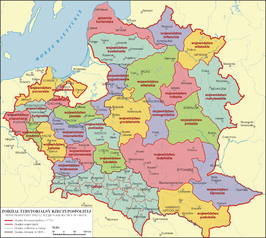Polish National Government (January Uprising)
| Polish-Lithuanian-Ruthenian Commonwealth (January Uprising) | ||||||
| Rzeczpospolita Trojga Narodów (Powstanie styczniowe) | ||||||
| ||||||
| ||||||
| Motto Latin: Si Deus Nobiscum quis contra nos (If God is with us, then who is against us) Latin: Pro Fide, Lege et Rege (For Faith, Law and King) | ||||||
 Claimed borders of the Polish–Lithuanian–Ruthenian Commonwealth during the January Uprising | ||||||
| Capital | Warsaw Wilno Kiev | |||||
| Languages | Polish Litvanian Ruthenian | |||||
| Religion | Roman Catholic Church Belarusian Greek Catholic Church Ruthenian Catholic Church | |||||
| Government | Polish National Government (January Uprising) | |||||
| Dictator of the Uprising | Karol Majewski | |||||
| Romuald Traugutt | ||||||
| Kastuś Kalinowski | ||||||
| Zygmunt Sierakówski | ||||||
| Antanas Mackevičius | ||||||
| Reds | Jarosław Dąbrowski Ignacy Chmieleński Stefan Bobrowski | |||||
| Legislature | Sejm | |||||
| History | ||||||
| - | January Uprising | January 22, 1863 | ||||
| - | Disestablished | 1865 | ||||
Polish National Government 1863–64- underground Polish supreme authority during January Uprising against Russian occupation of Poland. It had collegial form, resided in Warsaw and was headed by Karol Majewski. This was normal administrative institution with many ministries and departments.
During 1863-1864 it was a real shadow government supported by majority of Poles, who even paid taxes for it and a significant problem for Russian secret police (Okhrana). It became inspiration for Polish Secret State during World War II. Poland regained its independence from Russia, Prussia and Austro-Hungary in 1918.
References
- Aleksander Waszkowski (1841-1865) President of the Polish National Government (April 1864 - Arrested Dec 1864), Executed 1865
- Norman Davies, God's Playground, Volume 2 CUP 1982 (ISBN 0-231-05353-3)

